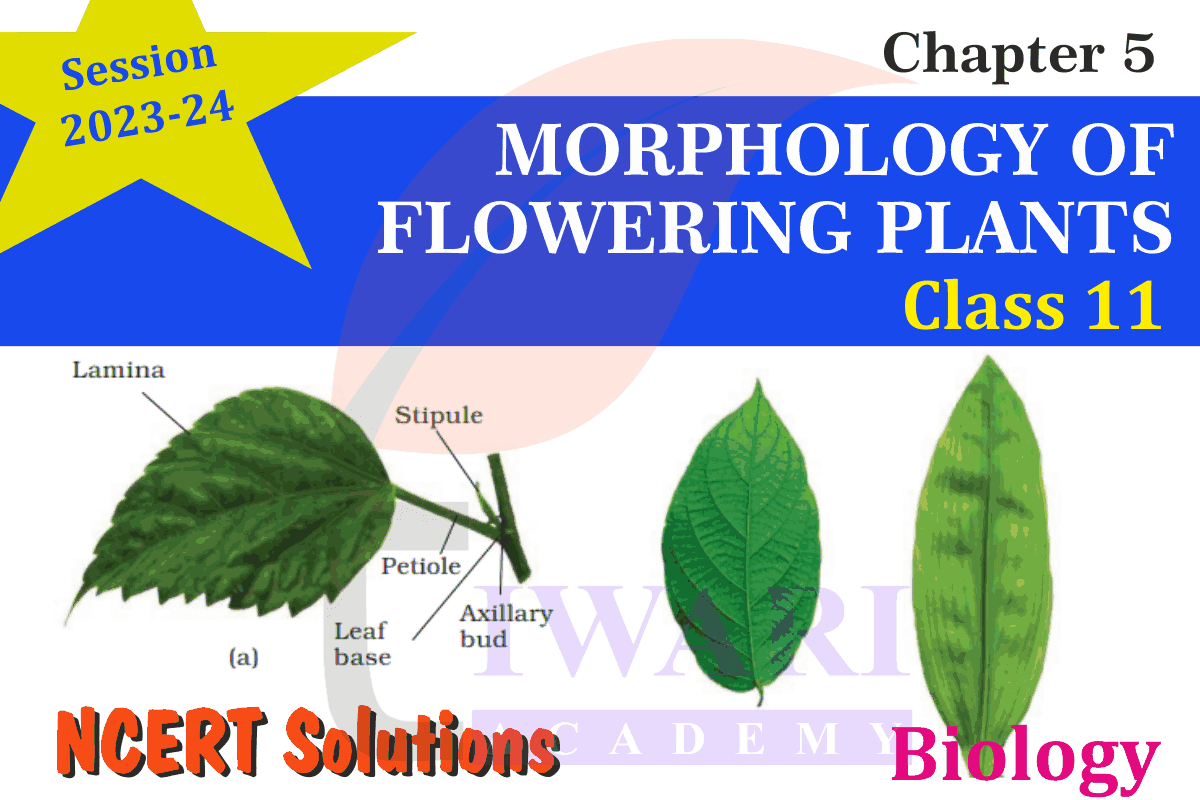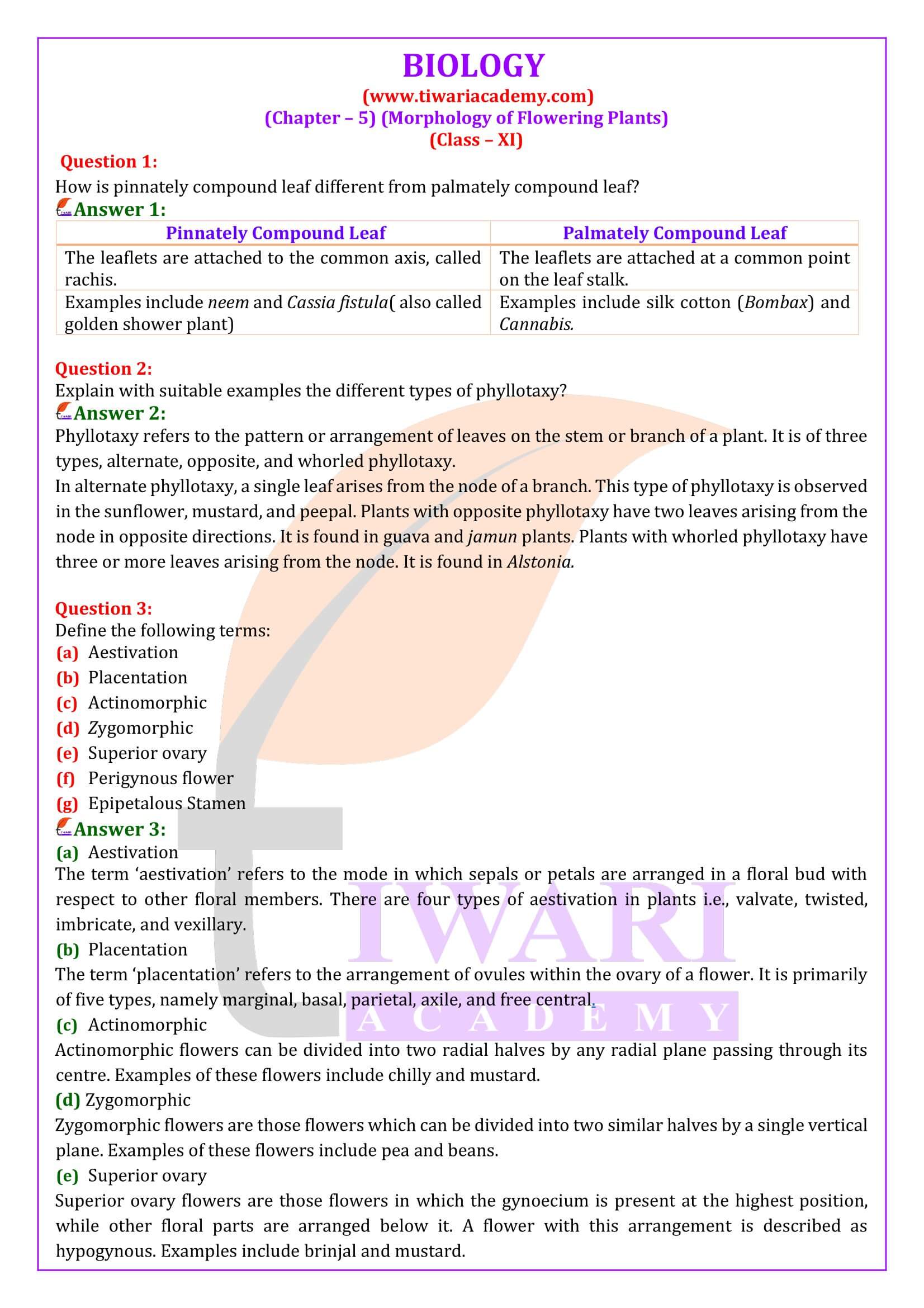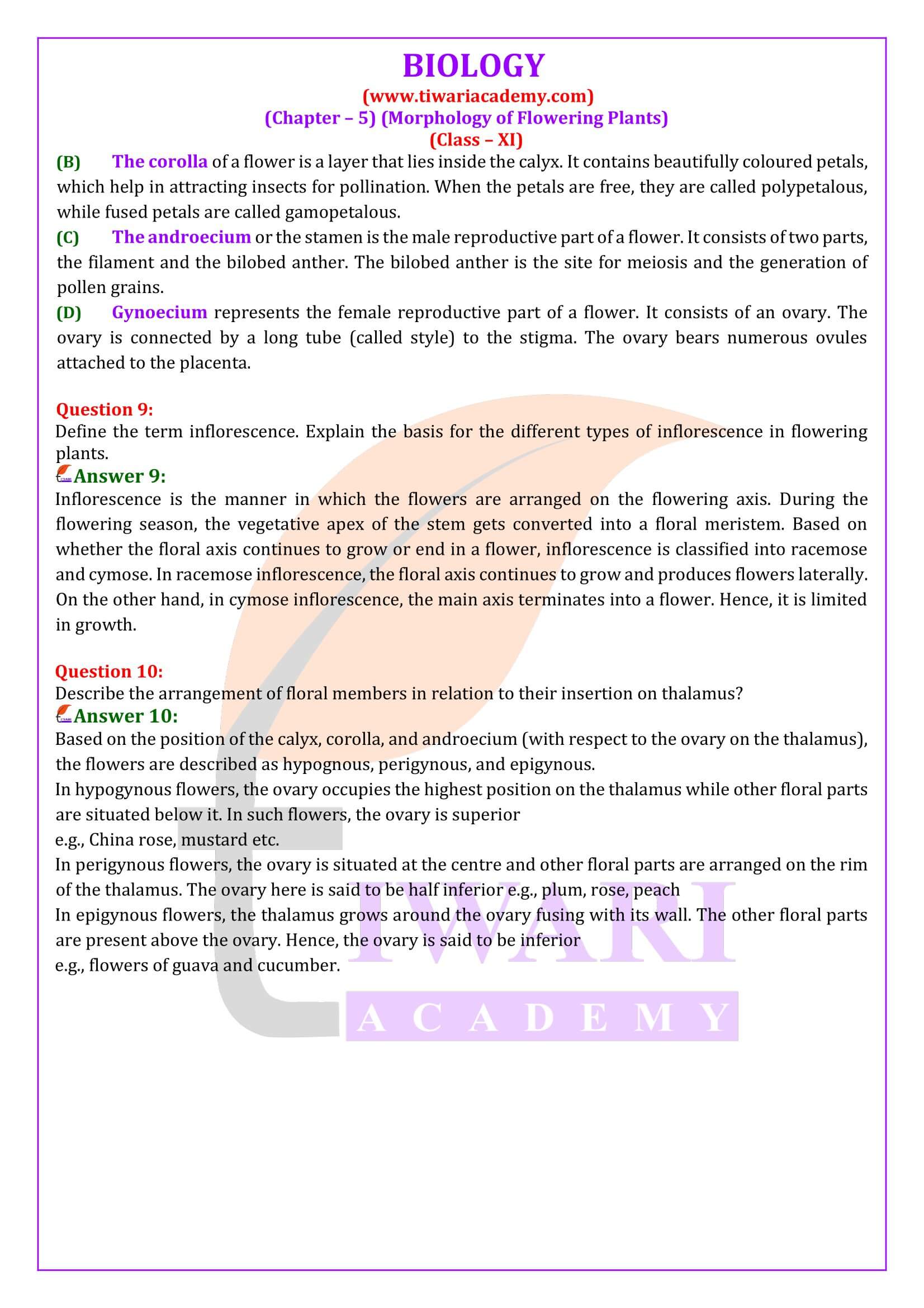NCERT Solutions for Class 11 Biology Chapter 5 Morphology of Flowering Plants in Hindi and English Medium Free updated and revised for new academic session 2025-26. NCERT Solutions 2025-26 of other subjects with Offline Apps are also available to free download. Join Discussion Forum to share your knowledge with the others.
NCERT Solutions for Class 11 Biology Chapter 5

| Class: 11 | Biology |
| Chapter 5: | Morphology of Flowering Plants |
| Content: | Exercises and Extra Question Answers |
| Content Format: | Images, PDF, Text and Videos |
| Academic Session: | 2025-26 |
| Medium used: | Hindi and English |
Class 11 Biology Chapter 5 Solutions in English
NCERT Solutions for Class 11 Biology Chapter 5 in PDF format to free download is given below updated for new academic session 2025-26. Share your knowledge with Discussion Forum and ask your educational doubts. Download NCERT Books 2025-26 for new session based on latest CBSE Syllabus 2025-26.

Important Terms on Morphology of Flowering Plants
1. The Root: The root is underground part of the plant and develops from elongation of radicle of the embryo.
MAIN FUNCTIONS OF ROOT SYSTEM
1. Absorption of water and minerals from the soil.
2. Provides anchorage to plant parts.
3. Stores reserve food material and synthesises plant growth regulators (cytokinins).
Regions of Roots
1. Root Cap: The root is covered at the apex by the thimble-like structure which protect the tender apical part.
2. Region of meristematic activity: Cells of this region have the capability to divide; cells are small, thin walled with dense protoplasm.
3. Region of elongation: Cell of this region are elongated and enlarged. This region is responsible for the growth of root in length.
4. Region of Maturation: This region has differnentiated and matured cells.
Some epidermal cells form very fine and delicate thread like structures called root hairs.
5. Modifications of Root: Roots are modified for support, storage of food, respiration.
MODIFICATIONS OF STEM
1. In some plants the stems are modified to perform the function of storage of food, support, protection and vegetative propagation.
2. For food storage: Rhizome (ginger, turmeric), Tuber (potato), Bulb (onion), Corm (Colocasia, Amorphophallus/Zamin-kand)
3. For support: Stem tendrils of wawtermelon, grapevine, cucumber, pumpkins.
4. For protection: Axilliary buds of stem of Citrus, Bougainvillea get modified into pointed thorns. They protect the plants from animals.
5. For vegetative propagation: Underground stems of grass (runner), strawberry (stolons), leateral branches of mint and jasmine, Eichhornia (offsets).
6. For assimilation of food: Flattened stem of Opuntia and cylindrical stem of Euphorbia contains chlorophyll and performs photosynthesis.
Types of aestivation
1. Valvate: Sepals or petals just touch one another at the margin, without overlapping. e.g., Calotropis
2. Twisted: Sepals or petals overlap the next sepal or petal e.g., China rose, Cotton, lady’s finger.
3. Imbricate: The margins of sepals or petals overlap one another but not in any definite direction, e.g., Cassia, Gulmohar.
4. Vexillary: The largest petal overlaps the two lateral petals which in turn overlap two smallest anterior petals, e.g., Bean, Pea.
Important Questions on 11th Biology Chapter 5
What is meant by modification of root? What type of modification of root is found in the Banyan tree.
Primarily, there are two types of root systems found in plants, namely the tap root system and fibrous root system. The main function of the roots is to absorb water and minerals from the soil. However, roots are also modified to perform various other functions. The roots of some plants act as storage sites for food, some provide support to massive plant structures, while others absorb oxygen from the atmosphere. Roots and its modifications in Banyan tree The banyan tree (Ficus benghalensis) has massive pillar-like adventitious roots arising from the aerial part of the stem. These roots grow towards the ground and provide support to the tree. Such roots are called prop roots.
Justify the following statements on the basis of external features Underground parts of a plant are not always roots.
Various parts of plants are modified into underground structures to perform various functions such as stems, leaves, and even fruits. The stems in ginger and banana are underground and swollen due to storage of food. They are called rhizomes. Similarly, corm is an underground stem in Colocasia and Zamin-khand. The tips of the underground stem in potato become swollen due to the accumulation of food and forms tuber. Tubers bear eyes, which are subtended by a leaf scar. Basal leaves in onions become fleshy because of the accumulation of food. In peanuts, the flower after fertilization gets pushed inside the soil by growing a flower stalk. The formation of fruits and seeds takes place inside the soil.
Explain with suitable examples the different types of phyllotaxy?
Phyllotaxy refers to the pattern or arrangement of leaves on the stem or branch of a plant. It is of three types, alternate, opposite, and whorled phyllotaxy. In alternate phyllotaxy, a single leaf arises from the node of a branch. This type of phyllotaxy is observed in the sunflower, mustard, and peepal. Plants with opposite phyllotaxy have two leaves arising from the node in opposite directions. It is found in guava and jamun plants. Plants with whorled phyllotaxy have three or more leaves arising from the node. It is found in Alstonia.
Define the term Aestivation.
Aestivation: The term ‘aestivation’ refers to the mode in which sepals or petals are arranged in a floral bud with respect to other floral members. There are four types of aestivation in plants i.e., valvate, twisted, imbricate, and vexillary.
Describe modifications of stem with suitable examples.
Stems of various plants have undergone modifications to perform different functions. Underground stems or storage stems: Examples: Rhizomes, Corms, tubers In ginger and banana, the underground stem is called a rhizome. The underground stem in Colocasia (arvi) is known as corm. Rhizomes and corms are underground stems, modified for the storage of food. Also, these stems help in vegetative reproduction of these plants. The tips of the underground stem in potato plants become swollen due to the accumulation of food. The potato is a tuber that helps in the storage of food and bears eyes on it. Subtended by a leaf scar, these eyes bear buds that give rise to new plants. Supportive stems Example: tendril The stem in some weak plants bear thin, slender, and spirally-coiled structures called tendrils that help the plant get attached to nearby structures for support. Tendrils are found in cucumbers, melons, and other members of the family Cucurbitaceae. Protective stems Example: Thorns The stem in bougainvillea and citrus plants (like lemon and orange) bear sharp, pointed structures called thorns, which provide protection to the plant from herbivores. Photosynthetic stems Example: Opuntia The stem in the Opuntia is green. It carries out the process of photosynthesis in the absence of leaves. Others stem modifications In some plants, underground stems such as grasses spread in the soil and help in perenation. These stems are called runners. The short lateral stem called the offset in some aquatic plants (such as Eichhornia) bears leaves and tufts of roots at the node and gives rise to new plants.
Take one flower each of families Fabaceae and Solanaceae and write its semitechnical description.
Family Fabaceae/Papilionaceae (pea plant) Fabaceae/Papilionaceae is a sub-family of the Leguminoseae family. Vegetative features: Habit: Pinnately compound, alternately arranged with leaf tendrils with the pulvinus present at the leaf base along folacious stipules. Root: Tap root system with root nodules. Floral features: Inflorescence: Racemose, generally axial than terminal Flower: Zygomorphic and bisexual flowers are found Calyx: It contains five sepals which are gamosepalous while aestivation is imbricate. Corolla: It contains five petals (polypetalous) with vexillary aestivation. Androecium: It consists of ten anthers that are diadelphous with dithecous anthers. Gynoecium: Monocarpellary superior ovary which is unilocular with marginal placentation. Fruit: Legume pod with non-endospermic seeds
What is a flower? Describe the parts of a typical angiosperm flower?
A flower can be defined as the reproductive unit of any flowering plant (angiosperms). Flowers carry out sexual reproduction in angiosperms. A typical flower is a modified stem with a condensed axis. A flower has four different parts i.e., the calyx, corolla, androecium, and gynoecium. Androecium and gynoecium represent the male and female reproductive organs of a flower (respectively). Bisexual flowers are those which contain both androecium and gynoecium, while unisexual flowers contain either gynoecium or androecium. The corolla and the calyx are generally distinct, but may sometimes be fused (called perianth). A flower that contains all four floral parts is called a complete flower. Parts of flowers (A) The calyx forms the outermost whorl of a flower, which contains sepals. They are green, leaf–like structures that cover and protect the flowers during the bud stage. When the sepals of a flower are free, they are called polysepalous, while fused sepals of a flower are called gamosepalous. (B) The corolla of a flower is a layer that lies inside the calyx. It contains beautifully coloured petals, which help in attracting insects for pollination. When the petals are free, they are called polypetalous, while fused petals are called gamopetalous. (C) The androecium or the stamen is the male reproductive part of a flower. It consists of two parts, the filament and the bilobed anther. The bilobed anther is the site for meiosis and the generation of pollen grains. (D) Gynoecium represents the female reproductive part of a flower. It consists of an ovary. The ovary is connected by a long tube (called style) to the stigma. The ovary bears numerous ovules attached to the placenta.
How do the various leaf modifications help plants?
The main function of the leaves is to carry out the process of photosynthesis. However, in a few plants, leaves are modified to perform different functions. (a) Tendrils: The leaves of a pea plant are modified into tendrils that help the plant in climbing. (b) Spines: The leaves in cactus are modified into sharp spines that act as an organ of defence. (c) Phyllode: The leaves of some Australian acacia are short-lived and soon replaced by flattened, green structures called phyllodes that arise from the petiole of the leaves. The petioles in these plants synthesize food. (d) Pitcher: The leaves of the pitcher plant are modified into pitcher-like structures, which contain digestive juices and help in trapping and digesting insects.









